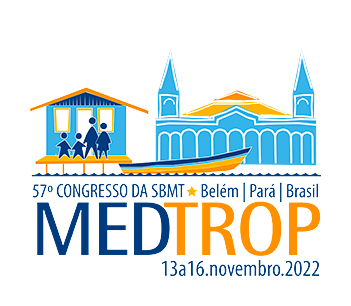Dados do Trabalho
Título
Surveillance of SARI cases associated with Repiratarory Syncytial Virus during the SARS-CoV-2 pandemic period in Brazil (2020 to 2022)
Introdução
Respiratory Syncytial Viruse (RSV), is a common respiratory virus that usually causes mild, cold-like symptoms, but it can be serious, especially for infants (bronchiolitis and pneumonia) and older adults.
Objetivo(s)
In this study we describe the epidemiological features of RSV in the Brazilian SARI cases during the COVID-19 pandemic.
Material e Métodos
SARI cases were collected from epidemiological week (EW) EW01/2020 to EW20/2022 into the National Surveillance Program for Influenza and other respiratory viruses and the detection of RSV were performed by real time RT-PCR. These data were reported in the National Epidemiological Surveillance Information System (SIVEPGripe). Epidemiological analyzes were performed.
Resultados e Conclusão
During January 2020 to May 2022, 8,568 SARI for RSV cases were recorded, from these 176 were deceased cases. 9% (n = 783/8,568) in 2020, 56% (n = 4,780/8,568) in 2021, 35% (n = 3,005/8,568) in 2022 up to EW20. Between the SARI cases, RSV were present mainly in children less than 2 y.o. (85%), followed by children between 3 to 6 y.o. (8%), and older adults more than 60 y.o. (4%). Regarding SARI deaths caused by RSV, mainly children less than 2 y.o. (55%) and older adults more than 60 y.o. (27%) were affected. Among these deceased cases, 58% (102/176) had one or more risk factors, heart desease represented 39% (40/102) of deceased cases. In 2020 before the beginning of SARS-CoV-2 circulation from January to March, Southeast (47%, 207/445) and Midwest (21%, 94/445) were the Brazilian regions that reported more SARI cases associated with RSV. November to December, the Northern Brazilian region presented a high number of cases, 52% (n = 99/190). In 2021, the cases were protagonists in Sudeste (58%, 816/1,416) and Midwest (17%, 242/1,416) from January to March, peak during the EW09 to EW11, respectively. April to September 2021, the cases were dominant in the South Brazilian region (46%, 865/1,890, peak EW27). At the end of the year, the Southeast region reported again an increase of cases (56%, 828/1,473, peak EW44). Up to the EW20/2022 the Southeast reported 40% (1,193/3,005) of RSV cases associated with SARI cases. During the COVID-19 pandemic there were observed more reports of SARI cases associated with RSV in children less than 2 y.o in all Brazilian states. It may be related to a more sensitive notification in the system due to the health emergency. Continuous laboratorial tests and homogeneous data is needed to keep the RSV surveillance in the country.
Palavras-chave
RSV; Surveillance; Brazil
Área
Eixo 10 | Outras infecções causadas por vírus
Categoria
NÃO desejo concorrer ao Prêmio Jovem Pesquisador
Autores
Felipe Cotrim de Carvalho, Greice Madeleine Ikeda do Carmo, Cássia de Fátima Rangel Fernandes, Marilda Agudo Mendonça Teixeira de Siqueira, Paola Cristina Resende Silva, Ana Pérola Drulla Brandão , Daiana Araujo da Silva , Luana Seles Alves , Matheus Almeida Maroneze, Walquiria Aparecida Ferreira de Almeida
